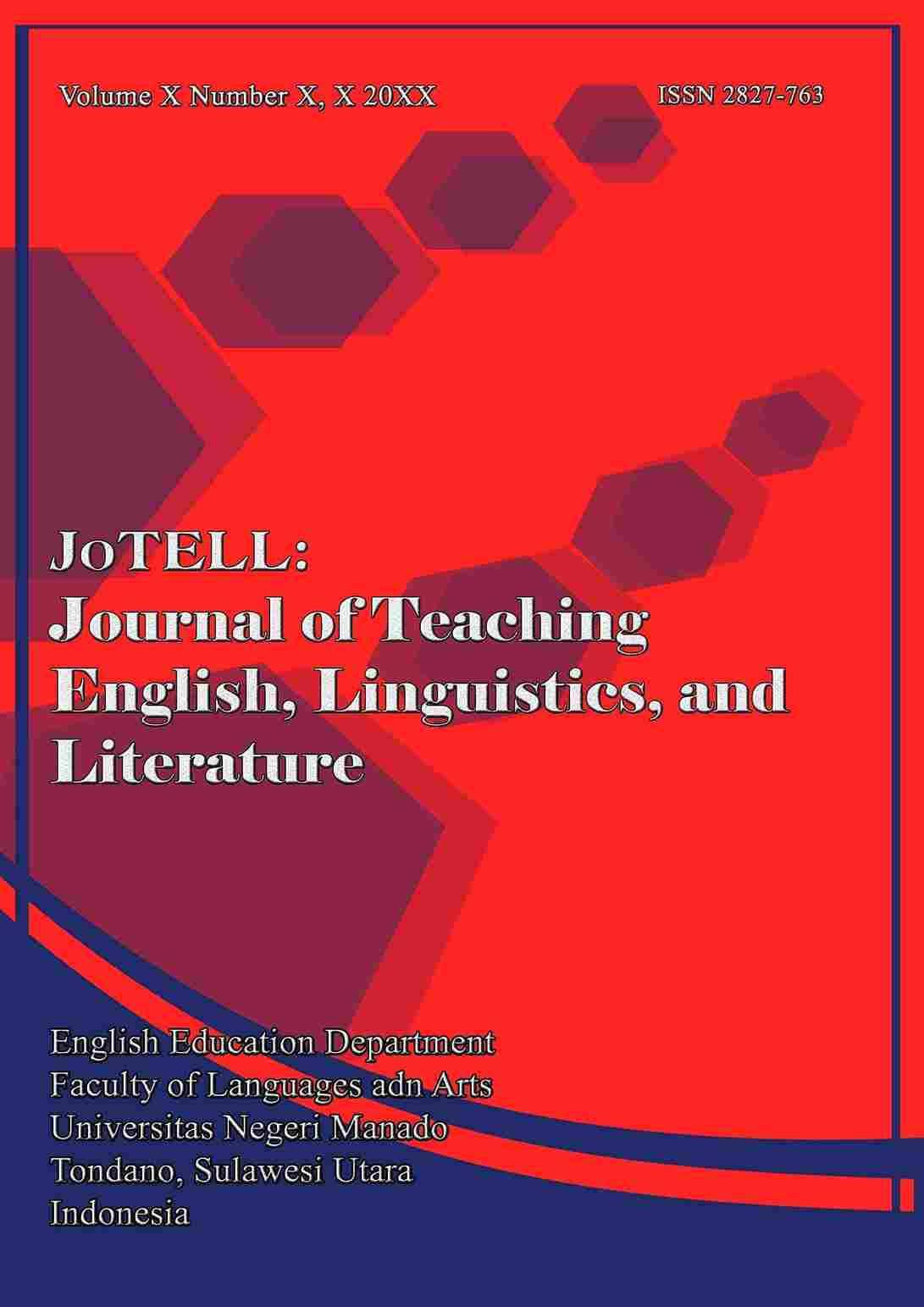THE IMPACT OF SOCIAL CLASS IN JANE AUSTEN PERSUASION
DOI:
https://doi.org/10.36582/jotell.v2i5.6409Keywords:
Social Class, Impact, Status, VictorianAbstract
The purpose of this research is to reveal the impact of social class reflected in Jane Austen’s Persuasion. The writer used the qualitative method because this research analyzed and collects data from the novel by the type of characters, the story, and the social class that occurs in the novel. In analyzing the data the writer used mimetic theory, the data were collected in the novel Persuasion by Jane Austen, the writer read the novel and identified the characters, the story that related to social class that occurs in the novel, to support this research the writer used several books, journal, and web pages. The novel tells about social class in the Victorian era, where class and status affect someone’s life. Social class is a group of people that share similar status, occupation, and wealthiness. This novel tells about a couple that was separated because of the social status differences, where Captain Wentworth is a man with unstable finances, while Anne Elliot is a woman from the upperclass social status. They were separated because of the persuasion of Lady Russel which causes Sir Walter Elliot which is Anne’s father to separate them. Sir Walter Elliot is a hedonist which ends him in bankruptcy. The result of the finding is that social class has an impact on human life and society. Social class differences affect many aspects ranging from lifestyle, life chances, and inequality of social status.
References
Austen, J. (2019). Persuasion. PT Gramedia Pustaka Utama Jakarta.
Barada, V. (2013). Sarah J. Tracy, Qualitative Research Methods: Collecting Evidence, Crafting Analysis, Communicating Impact. In Revija za sociologiju (Vol. 43, Issue 1). https://doi.org/10.5613/rzs.43.1.6
Barret, K. L. (2013). Victorian Women and Their Working Roles. http://digitalcommons.buffalostate.edu/cgi/viewcontent.cgi?article=1009&context=english_theses
Glass, L. J. (2022). Understanding Relationship Seperation. Pivot. https://www.lovetopivot.com/what-separation-emotional-stages-couples-intimacy-retreat/
Grusky, D. (2019). Social Stratification, Class, Race, and Gender in Sociological Perspective, Second Edition. In Social Stratification, Class, Race, and Gender in Sociological Perspective, Second Edition. https://doi.org/10.4324/9780429306419
Holt, J. P. (2014). The social thought of karl marx. In The Social Thought of Karl Marx. https://doi.org/10.4135/9781483349381
Keles, K., Wuntu, C. N., & Lolowang, I. (2022). A Family Portrait In Nicholas Sparks’novel The Last Song. JoTELL: Journal of Teaching English, Linguistics, and Literature, 1(3), 360-374.
Makalew, G. A., Rorintulus, O., & Kamagi, S. (2022). The Shopaholic Lifestyle In Sophie Kinsella The Secret Dreamworld Of A Shopaholic. JoTELL: Journal of Teaching English, Linguistics, and Literature, 1(2), 221-243.
Maru, M. G. (2014). The Stereotype of American Upper Class Woman in the Late Ninetenth Century he Stereotype of American Upper Class Woman in the Late Ninetenth Century ( A Case Study of New York Woman: Vol. I.
Norton, D. S., Rushton, P., & Abrams, M. H. (1957). A Glossary of Literary Terms. College Composition and Communication, 8(4). https://doi.org/10.2307/354930
Pollingug, A. B., & Williams, L. D. (1995). Theory into Practice. In Intervention in School and Clinic (Vol. 31, Issue 1). https://doi.org/10.1177/105345129503100110
Pratap, V., Tomar, S., Dwivedi, D., & Gwalior, M. (2015). International Journal of Advance Engineering and Research Development “Social Class In Victorian Era.†Simulation of Field Oriented Control of Permanent Magnet Synchronous Motor, 2(4), 630–636.
Rorintulus, O. A., Wuntu, C. N., Tatipang, D. P., Lolowang, I., & Maukar, M. M. (2022). Discrimination Over Women As Depicted In Walker’s And Tohari’s Work: A Comparative Study. ELITE: English and Literature Journal, 9(2), 159-177.
Steinbach, S. L. (2016). Understanding the Victorians. In Understanding the Victorians (Second Edi). Routledge Taylor & Francis Group. https://doi.org/10.4324/9781315545301
Takamuntu, Y. C., Wuntu, C. N., & Rorimpandey, R. S. (2022). Self-Actualization Of The Main Character In Disney’s Cruella Movie. KOMPETENSI, 2(02), 1171-1182.
Talumepa, Z., Rorintulus, O., & Lolowang, I. (2022). The Bravery In Nicola Yoon’s Everything, Everything. JoTELL: Journal of Teaching English, Linguistics, and Literature, 1(7), 865-878.
Tungka, J. K., Rorintulus, O., & Andries, F. A. (2022). Sacrifice As Described In Oscar Wild’s The Nightingale And The Rose. JoTELL: Journal of Teaching English, Linguistics, and Literature, 1(2), 305-315.
Valufi, E., & Astuti, R. B. (2020). Types of Hedonism on the Main Character Sir Walter Elliot in the Novel Persuasion By Jane Austen. Journal of Language and Literature, 8(1), 30–43. https://doi.org/10.35760/jll.2020.v8i1.2525
Downloads
Published
How to Cite
Issue
Section
License
Copyright (c) 2023 JoTELL : Journal of Teaching English, Linguistics, and Literature

This work is licensed under a Creative Commons Attribution-ShareAlike 4.0 International License.












